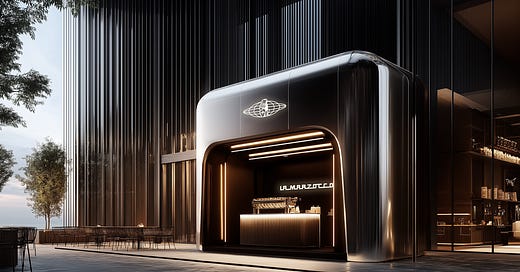There’s a certain kind of person who calibrates their espresso shots with a digital scale. Who knows that a 25-30 seconds of extraction is the sweet spot. Who upgrades their grinder before their mattress. These are not “coffee drinkers.” These are believers.
La Marzocco built the Linea Micra for them.
Not the hobbyist. Not the gift-buying spouse. Not the “I need caffeine before my Zoom” set. The Micra is a compact, industrial-grade, counter-unfriendly piece of equipment that costs more than most couches—and it’s sold like a religious artifact. Obsessive. Quietly excellent.
The Micra doesn’t try to win over everyone. It wins deeply with a few—and as a result, builds gravitational pull from everyone else. That’s what makes it special.
It’s also what makes it a perfect metaphor for how spatial brands should behave—and almost never do.
Real estate tends to fear specificity. Hotels want to be “approachable.” Restaurants want to be “elevated but casual.” Offices want to “support collaboration and focus.” Apartments want to be “for the widest net possible.”
That approach might feel safe. But it’s the fastest path to sameness. If you’re building something that everyone can imagine themselves in, you’re probably building something no one feels connected to.
Most real estate development still thinks in terms of space types and price points. Studio, one-bed, two-bed. Class A, B, or C. Warm neutral lobby. Gym that looks like a hotel. Hotel that looks like every other hotel. Coffee machine in the corner. A vibe that whispers: it’s basically what you expect.
But the spaces people love—talk about, evangelize, return to—don’t just meet a basic need. They reflect a worldview. They align with identity. They feel like they were made for you.
The best brands do three things exceptionally well:
They know who they’re for.
Not demographically, but in terms of attitudes and behaviors. They understand their customer’s values, rituals, aspirations—and they build from there.They design the product and experience around those values.
Not around category norms. Not around competitive feature lists. But around what that specific group of people actually needs and wants in their lives.They stay in character.
Every touchpoint reinforces the promise. There are no off-brand moments. No lazy packaging. No copy-paste signage. No “that’s just the ops team” excuses.
This is what real estate can—and should—steal. Because whether you’re building a hotel, a workspace, an apartment, or a retail concept, you’re no longer just delivering square footage. You’re delivering story. And people opt into stories that reflect their own.
Let’s make it concrete. Instead of pulling from precedent, designing based on your interior team’s “style” or referencing the dreaded “But I like this, so let’s do this” start here:
01. Define your customer bullseye.
Put down the demographic deck. Who is your product really for? What do they believe in? How do they spend their weekends? What’s their search history? What makes them say, “Finally, someone gets me”?
Don’t say “young professionals.” Say: creatively-inclined soloists who crave control over their schedule and will always choose mood over mainstream.
Don’t say “families.” Say: design-conscious parents who want their kids to be around culture without giving up calm.
02. Make one big promise—and keep it everywhere.
If your space is about creative energy, it should feel electric—from the materials to the playlist to the event calendar. If your brand is about comfort and slowness, make sure the corridors aren’t blasting fluorescent light and the facade isn’t covered in a rainbow geometric mural.
Good brands pick a lane. Great ones pave it all the way to the front door.
03. Use your design budget like a product company.
Product brands don’t blow the whole budget on the outer shell. They invest in the things people touch, use, and remember.
Some examples, in spatial terms:
Spend on signage, scent, sound, and first impressions.
Rethink the welcome moment (digital or physical).
Kill the generic wayfinding.
Budget for good paper and collateral.
Apply brand to the interior of the interiors.
04. Think in user journeys, not feature sets.
You don’t need to build a golf simulator. You need to design a day in someone’s life—then make sure your space is the best version of that day. From morning to night, from “where’s my coffee” to “where do I put my feet up.”
Most amenities are designed in isolation. But life happens in sequence.
05. Get religious about consistency.
If you’re positioning your office building as a playground for creative thinkers, the email you send to schedule the tour can’t sound like it was written by legal. If your apartment brand is all about wellness, your vending machines can’t just have Diet Coke and corn syrup bars.
The brands that hit hardest are the ones where every piece feels cut from the same cloth. Not over-designed. Just intentional.
We’ve said this before, but it’s worth repeating: sameness is a disease. It shows up in the furniture package. The pool tile. The room numbering system. The website headline that reads like every other building in the zip code.
But the antidote isn’t shock value. It’s alignment. Brand alignment. Customer alignment. Cultural alignment.
Because when people feel seen, they stick around. When they feel inspired, they tell their friends. And when they feel like you built something just for them, they don’t ask about price per square foot.
So no, don’t brand for everyone.
Brand like a cult product. Know your people. Speak their language. Show up for them like you mean it.
And let the rest opt out.
Because you’re not building a space for everyone. You’re building a world someone wants to belong to.
Missed our last article? Read it now.
The Consumerization of Spaces
This article was recently published on Thesis Driven. Thesis Driven dives deep into emerging real estate themes and opportunities.
Missed our feature in The Brand Identity? Check it out now.
🚨 WHO IS NO WALLS STUDIO (AND WHAT DO WE DO)?
No Walls Studio is a design and brand consultancy that helps real estate developers create spaces that people love.
Our mission is to make sameness extinct in real estate, which means that everything we do comes with new ideas and unique angles — all, grounded in a deep understanding of culture and consumers.
We do three things for our clients (often, all in the same project):
Research & Insights
Brand Development
Spatial Experience Design
Want to work with us or learn more?















